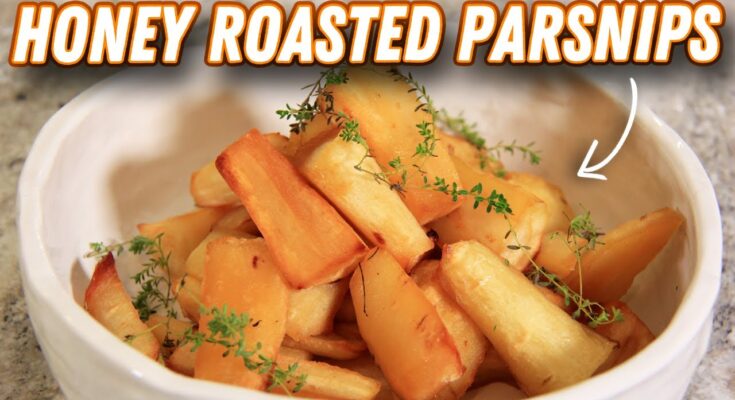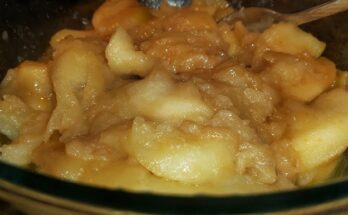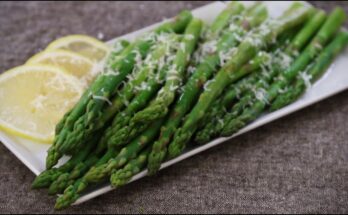Parsnip Recipe: Parsnips are one of those old-school root vegetables that might remind you of a paler carrot. They’re part of the same family, but parsnips bring their own unique sweetness and nutty flavor to the table. Historically, people used them as a staple food before potatoes were widely available. Their creamy white flesh and slightly rough exterior make them easy to spot in any produce section.
What’s special about parsnips is how versatile they are. You can roast them, mash them, bake them into chips, or even toss them into a soup. Their texture is starchy like a potato, but they have a naturally sweet and earthy flavor, which makes them a great addition to savory dishes.
Health Benefits of Parsnips
Parsnips aren’t just tasty—they’re a powerhouse of nutrients. They’re high in fiber, which supports digestion and helps you feel full longer. They also pack in essential vitamins like C, K, and folate. The potassium in parsnips helps regulate blood pressure and supports heart health.
Plus, they’re low in calories and fat, making them a guilt-free addition to any meal. The antioxidants in parsnips help fight off inflammation and may boost your immune system. So next time you’re meal planning, consider tossing in this nutrient-rich veggie.
Why Cook with Parsnips?
Let’s be real—parsnips are often overlooked, but they’re incredibly rewarding in the kitchen. They caramelize beautifully when roasted, pair well with herbs and spices, and add a comforting touch to winter meals. If you’re bored with potatoes or carrots, parsnips are your new best friend.
They’re also budget-friendly and have a longer shelf life than many other veggies, which makes them perfect for meal prep or stretching your grocery budget. And because they’re naturally sweet, they work well even in healthier desserts!
Ingredients You’ll Need
Core Ingredients
For this easy, delicious roasted parsnip recipe, you’ll need:
- 4-5 medium parsnips, peeled and chopped
- 2 tablespoons olive oil (or melted butter)
- 1 teaspoon sea salt
- ½ teaspoon black pepper
That’s it for the base. These simple ingredients allow the natural flavor of the parsnips to shine.
Optional Add-ins for Extra Flavor
If you want to elevate your parsnips even more, consider adding:
- 1 teaspoon garlic powder or 2 fresh garlic cloves, minced
- 1 tablespoon fresh rosemary or thyme
- A drizzle of honey or maple syrup for extra caramelization
- Grated parmesan cheese for a savory finish
- Paprika or chili flakes for a bit of heat
These extras take roasted parsnips from good to unforgettable. It’s all about balancing sweet and savory to your taste.
Step-by-Step Parsnip Recipe
Step 1 – Washing and Peeling Parsnips
Start by scrubbing your parsnips under cold water to remove dirt. Even if they look clean, a good rinse is necessary. Use a vegetable peeler to strip away the skin—it’s a bit tough and can taste bitter when roasted. If your parsnips are large and have a woody core, slice them lengthwise and remove the center to keep the texture tender.
This step might seem basic, but prepping your parsnips correctly is crucial. A well-peeled parsnip ensures you get a smooth bite every time without any fibrous interruptions. Plus, properly washed parsnips won’t turn muddy during roasting.
Step 2 – Slicing and Preparing for Cooking
Cut your peeled parsnips into uniform sticks or chunks. Aim for about the size of thick-cut fries—around 3 inches long and ½ inch thick. This size allows them to roast evenly and develop a crispy outside while staying soft inside.
Make sure not to overcrowd your baking sheet. Lay the pieces out in a single layer with some space between them. Crowding leads to steaming rather than roasting, and you want that golden-brown caramelization.
Step 3 – Roasting for Optimal Flavor
Preheat your oven to 400°F (200°C). Place the cut parsnips in a large mixing bowl, drizzle with olive oil, and toss with salt and pepper (plus any extras you’re adding). Spread them on a baking sheet lined with parchment paper or foil for easy cleanup.
Roast them in the oven for 30-35 minutes, flipping halfway through. You’re looking for golden edges and a tender center. Some darker, crispy bits? Even better. That’s where the flavor lives!
Step 4 – Seasoning Tips
Seasoning is what transforms a simple roasted vegetable into a memorable side dish. While salt and pepper are your foundation, don’t stop there. Parsnips pair well with warm spices and herbs, giving you a lot of freedom to play.
Try this combo: garlic powder, a pinch of cinnamon, and a drizzle of maple syrup. It sounds a little wild, but the sweetness of the syrup brings out the natural sugars in the parsnip, and the cinnamon adds a warm depth that tastes like fall in every bite.
For a savory twist, mix in some smoked paprika and rosemary. If you’re going Mediterranean, toss in oregano, lemon zest, and a sprinkle of feta after roasting. For those who like spice, chili flakes or cayenne pepper can add just the right amount of kick.
The secret? Season generously before roasting and adjust again right after cooking. This layering method intensifies the flavor and helps the seasoning stick better.
Step 5 – Serving Suggestions
Roasted parsnips are so good, they can easily be the star of the plate or the perfect supporting actor. You can serve them as a side dish for roasted chicken, grilled steak, or even baked fish. They also pair beautifully with a creamy mushroom sauce or a rich gravy if you’re leaning into comfort food.
Want to go vegetarian or vegan? Serve them alongside quinoa or lentils and sautéed greens. Or try stacking them on top of a hearty salad with kale, cranberries, and goat cheese.
Hosting brunch? Use roasted parsnips as a topping for avocado toast or mix them into a breakfast hash with eggs and onions. They’re even delicious in wraps and sandwiches—kind of like roasted sweet potato, but a little more complex in flavor.
Their versatility is unmatched. Whether you’re meal-prepping for the week or throwing together a quick dinner, roasted parsnips fit right in.
Cooking Variations
Mashed Parsnips
Forget mashed potatoes—mashed parsnips are where it’s at. They’re sweet, silky, and just different enough to surprise your taste buds. To make them, simply boil chopped parsnips in salted water until fork-tender (about 15–20 minutes). Drain and mash with a bit of butter, cream, and salt.
Want to take it to the next level? Add roasted garlic or a splash of truffle oil. You can even blend in some boiled carrots or potatoes for added color and texture.
Mashed parsnips go well with roasted meats, holiday meals, or as a fancy side to elevate a weekday dinner.
Parsnip Soup
Parsnip soup is a winter favorite—warm, creamy, and comforting. Start by sautéing onions and garlic in a pot, then add chopped parsnips and broth. Simmer until everything is tender, then blend until smooth.
A splash of cream makes it richer, but for a dairy-free version, use coconut milk—it adds a slight sweetness that complements the parsnips. Season with nutmeg, cumin, or even curry powder for a bold twist.
Garnish with croutons, fresh herbs, or a swirl of olive oil, and serve with crusty bread. Perfect for cozy nights in.
Parsnip Fries
Craving something crispy but healthier than regular fries? Parsnip fries are your answer. Cut the parsnips into thin strips, coat them lightly in oil and your favorite seasonings (like garlic powder, paprika, and sea salt), then roast or air-fry until golden and crisp.
Serve them with aioli, ketchup, or even a spicy yogurt dip. They’re a great snack, appetizer, or side—and kids love them too.
FAQs about Parsnip Recipe
1. What is the best way to store parsnips?
Store unpeeled parsnips in the fridge, wrapped in a paper towel inside a plastic bag. They’ll stay fresh for 2–3 weeks.
2. Can you eat parsnips raw?
Yes, you can! Raw parsnips have a crunchy texture and a slightly nutty flavor. Great for salads or veggie trays.
3. Are parsnips keto-friendly?
Parsnips are higher in carbs than other low-carb veggies, so they’re not ideal for strict keto diets. But in moderation, they can fit into low-carb lifestyles.
4. What herbs go best with parsnips?
Thyme, rosemary, sage, and parsley are excellent. They enhance the natural sweetness of the parsnips without overpowering them.
5. Can parsnips be substituted in other root veggie recipes?
Absolutely! You can use parsnips in place of carrots, potatoes, or turnips in most recipes. They bring a slightly sweeter taste and a similar texture.
Conclusion
Parsnips are the underdog of root vegetables, but once you give them a chance, you’ll wonder why you didn’t cook with them sooner. Whether you roast, mash, fry, or puree them into a soup, parsnips offer a sweet, earthy flavor that elevates any meal.
This simple step-by-step guide makes it easy to incorporate parsnips into your weekly meals. With just a few ingredients and a hot oven, you can transform this humble veggie into a side dish that steals the show. Try different variations, play with seasonings, and don’t be afraid to get creative. Your taste buds (and your dinner guests) will thank you.



